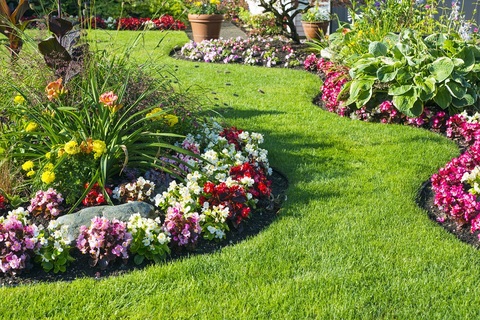Having a nice, green lawn is important for a home’s curb appeal. If your grass is looking brittle, brown, and just plain dead, it can make your entire property appear poorly maintained, no matter how much work you’re putting into it. But what can you do about your dead grass? The good news is, it’s probably not entirely dead, but rather only mostly dead. There is hope to give life to your brown grass. Keep reading to get tips from professional landscape contractors in Suwanee.
How Dead Is It?
As we’ve already mentioned, when it comes to your lawn, there’s dead, and then there’s mostly dead—or to put it in industry terms, dormant. During periods of drought, grass can go dormant in order to conserve water. The blades will turn brown and dry up, but the crowns will remain healthy. In order to determine if your grass is dormant or dead, you’ll need to take a close look at the crowns.
The crowns of your grass are the paler part of the grass from which individual blades emerge. If the crowns appear healthy, your lawn can be revived; if they’re brown and dry, then your grass probably won’t be coming back, regardless of how much water you give it.

Water, Water, Water
Assuming the crowns are healthy, your lawn is most likely brown because it’s gone dormant from a lack of water. So, watering your lawn much more frequently will be the most basic step towards bringing your lawn back to its lush, green self. Be sure to water either very early in the morning or later in the evening, so that the water doesn’t simply evaporate in the heat of the day. This will give you the greatest impact on your lawn without running up your water bill.
Aerate and Dethatch
Another technique for reviving your dead grass is to aerate and dethatch any dead areas. Aerating involves driving spikes into the ground at regular intervals, allowing fresh air to reach into the soil, and reducing soil compaction. You can rent a lawn aerator for a surprisingly low cost, and it only takes a couple of hours to aerate most suburban-sized lawns.
Dethatching refers to removing layers of dead plant materials that can accumulate beneath the upper layer of grass. This isn’t something you should do too frequently—at most every year or two—because it can be extremely stressful on your lawn. However, removing that dead plant material will revitalize your yard and get that grass growing green again.
Seed and Fertilize
Spreading some fresh grass seed in the dead areas of your lawn will allow new grass to take root where the old plants may have died off. It’s best to do this after thoroughly dethatching and aerating. Follow this up with some fertilizer to promote growth—and spread that fertilizer to the rest of your lawn as well, rather than just limiting it to the seeded areas. The extra nutrients will help your grass to become lush and green again.
If your lawn is looking brown and dead, contact the Stoeckig Landscape Group. We’ll help you determine the problem and get your grass green again. Or, if you decide that traditional landscaping is too high-maintenance for your taste, we can help you with xeriscaping or stone landscaping in Suwanee to make your yard beautiful without all the upkeep. Give us a call today!
